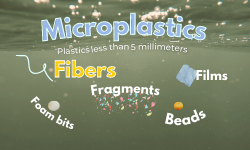 Microplastics are plastics that are less than 5 mm in size and a lot about them is unknown. Research has shown that microplastics can cause physical harm to wildlife when ingested. Microplastics can absorb other chemicals such as trace metals, polycyclic aromatic hydrocarbons, pesticides, and some pathogens. Initial research has also suggested that plastic additives can contribute to disruption in the endocrine system and possibly cancer. Currently, there are five types categorized by the USGS: fibers, foam, fragments, beads/pellets, and film. After a study of microplastics in the Great Lakes Region published in 2016 from USGS, they found that fibers were the most commonly found microplastic in the Maumee and Portage Rivers.
Microplastics are plastics that are less than 5 mm in size and a lot about them is unknown. Research has shown that microplastics can cause physical harm to wildlife when ingested. Microplastics can absorb other chemicals such as trace metals, polycyclic aromatic hydrocarbons, pesticides, and some pathogens. Initial research has also suggested that plastic additives can contribute to disruption in the endocrine system and possibly cancer. Currently, there are five types categorized by the USGS: fibers, foam, fragments, beads/pellets, and film. After a study of microplastics in the Great Lakes Region published in 2016 from USGS, they found that fibers were the most commonly found microplastic in the Maumee and Portage Rivers.
These little strings of plastic come from some surprising sources, our synthetic clothes, diapers, and cigarettes. When we wash our synthetic clothes, the synthetic fibers break off our clothing, slip past the water treatment plants, and end up right in our water. Unbeknown to most smokers, cigarettes are made of plastic fibers. When cigarettes are thrown on the ground and start to “break down” the fibers can break off and enter our waterways.
Help reduce the fibers by trying one of these tips from Huron River Watershed Council. Some helpful tips included:
- Looking for a filter for your washing machine
- Use laundry devices that capture microfibers
- Buy less synthetic clothing
And you can always join us on a clean-up to remove cigarette butts and clothing from our waterways before the fibers start to break off! Sign- up here
